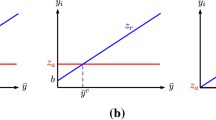Summary
In this paper we will deal with definitions ofsubjective poverty lines. To measure a poverty threshold value in terms of household income, which separates the poor from the non-poor, we take into account the opinions of all people in society. Three subjective methods will be discussed and compared,viz., the Leyden Poverty Line (LPL), the Subjective Poverty Line (SPL) and the Centre for Social Policy Poverty Line (CSP). In the empirical part of the paper we compute the average poverty line and a few corresponding characteristics for each definition.
Similar content being viewed by others
References
Aitchison, J. and J.A.C. Brown (1957),The Lognormal Distribution, Cambridge.
Colasanto, D., A. Kapteyn and J. van der Gaag (1984), ‘Two Subjective Definitions of Poverty: Results from the Wisconsin Basic Needs Study,’Journal of Human Resources, 19, pp. 127–137.
Danziger, S., J. van der Gaag, M.K. Taussig and E. Smolensky (1984), ‘The Direct Measurement of Welfare Levels; How Much Does it Cost to Make Ends Meet?,’Review of Economics and Statistics, 66, pp. 500–505.
Deleeck, H. (1977), ‘Bestaanszekerheid en het Sociale Zekerheidsstelsel in Belgie-1974,’Belgisch Tijdschrift voor Sociale Zekerheid, 19, pp. 1–23.
Deleeck, H., J. Berghman and P. Janssens (1984), ‘Sociale Zekerheid: Inkomensverdeling en Doelmatigheid Anno 1982,’De Gids Op Maatschappelijk Gebied, 75, pp. 595–623.
Deleeck, H. and K. Van den Bosch (1989), ‘The Measurement of Poverty in a Comparative Context: Empirical Evidence and Methodological Evaluation of Four Poverty Lines in Seven EC-countries,’ Report presented at Noordwijk, SeminarPoverty Statistics in The European Community.
Efron, B. (1982),The Jackknife, the Bootstrap and Other Resampling Plans, Society for Industrial and Applied Mathematics, Philadelphia, Pennsylvania.
Engel, E., (1883), ‘Der Werth des Menschen. 1. Teil: Der Kostenwerth des Menschen,’Volkswirtschaftliche Zeitfragen, 37–38, pp. 1–74.
Fuchs, V. (1967), ‘Redefining Poverty and Redistributing Income,’Public Interest, Summer, pp. 88–95.
Ghiatis, A. (1989), ‘Low Income Groups Obtained by Enhanced Processing of the Household Budget Surveys in the EC - Summary Figures for Italy and The Netherlands,' Report presented at Noordwijk, SeminarPoverty Statistics in the European Community.
Goedhart, Th., V. Halberstadt, A. Kapteyn and B.M.S. van Praag (1977), ‘The Poverty Line: Concept and Measurement,’The Journal of Human Resources,12, pp. 503–520.
Hagenaars, A.J.M. and B.M.S. van Praag (1985), ‘A Synthesis of Poverty Line Definitions,’Review of Income and Wealth,31, pp. 139–153.
Hagenaars, A.J.M. (1986),The Perception of Poverty, Amsterdam.
Helson, H. (1964),Adaptation-Level Theory; An Experimental and Systematic Approach to Behaviour, New York.
Johnson, N.L. and S. Kotz (1971),Distributions in Statistics, Continuous Univariate Distributions-1, New York.
Kapteyn, A., T.J. Wansbeek and J. Buyze (1980), ‘The Dynamics of Preference Formation,’Journal of Economic Behaviour and Organization, 1, pp. 123–157.
Kapteyn, A., S. van de Geer and H. van de Stadt (1985), ‘The Impact of Changes in Income and Family Composition on Subjective Measures of Well-Being,’ in: M. David and T. Smeeding (eds.),Horizontal Equity, Uncertainty and Economic Well-Being, Chicago.
Moriani, C. (1989), ‘The Italian Experience on Poverty Harmonized Measures,' Report presented at Noordwijk, SeminarPoverty Statistics in the European Community.
Orshansky, M. (1965), ‘Counting the Poor: Another Look at the Poverty Profile,’Social Security Bulletin,28, pp. 3–29.
Pareto, V. (1909), Manuel d'économie politique, Paris.
Praag, B.M.S. van (1968),Individual Welfare Functions and Consumer Behavior, Amsterdam.
Praag, B.M.S. van (1971), ‘The Welfare Function of Income in Belgium: An Empirical Investigation,’European Economic Review, 2, pp. 337–369.
Praag, B.M.S. van and A. Kapteyn (1973), ‘Further Evidence on the Individual Welfare Function of Income: An Empirical Investigation in The Netherlands,’European Economic Review, 4, pp. 33–62.
Praag, B.M.S. van, Th. Goedhart and A. Kapteyn (1980), ‘The Poverty Line. A Pilot Survey in Europe,’Review of Economics and Statistics, 62, pp. 461–465.
Praag, B.M.S. van (1982), ‘A Comparison of Objective and Subjective Measures of Poverty,’ in: G. Sarpellon (ed.), Understanding Poverty, Istituto Internazionale ‘Jacques Maritain,’ Roma, Italy and Franco Angeli Libri s.r.l. Milano, Italy.
Praag, B.M.S. van, A.J.M. Hagenaars and J. van Weeren (1982), ‘Poverty in Europe,’Review of Income and Wealth, 28, pp. 345–359.
Praag, B.M.S. van (1988), ‘The Relativity of the Welfare Concept,' Report WP 69, World Institute for Development Economics Research of the United Nations University, Helsinki, forthcoming in: M. Nussbaum and A. Sen (eds.), The Quality of Life, Oxford.
Praag, B.M.S. van and N.L. van der Sar (1988), ‘Household Cost Functions and Equivalence Scales,’Journal of Human Resources,23, pp. 193–210.
Praag, B.M.S. van (1989), ‘Ordinal and Cardinal Utility: An Integration of the Two Dimensions of the Welfare Concept,’ forthcoming inThe Journal of Econometrics.
Rao, C.R. (1973),Linear Statistical Inference and its Applications, New York.
Robbins, L. (1932),An Essay on the Nature and Significance of Economic Science, 1st. ed., London.
Rowntree, B.S. (1901),Poverty: A Study of Town Life, London.
Sen, A. (1986),Economics and Ethics, London.
Teekens, R. and M.A. Zaidi (1989), ‘Relative and Absolute Poverty in The European Community; Results from Family Budget Surveys,' Report presented at Noordwijk, SeminarPoverty Statistics in the European Community.
Townsend, P. (1974), ‘Poverty as Relative Deprivation: Resources and Style of Living,' in: D. Wedderburn (ed.),Poverty, Inequality and Class Structure, London.
Author information
Authors and Affiliations
Rights and permissions
About this article
Cite this article
Flik, R.J., van Praag, B.M.S. Subective poverty line definitions. De Economist 139, 311–330 (1991). https://doi.org/10.1007/BF01423569
Issue Date:
DOI: https://doi.org/10.1007/BF01423569




